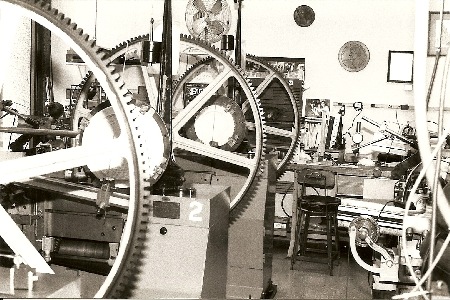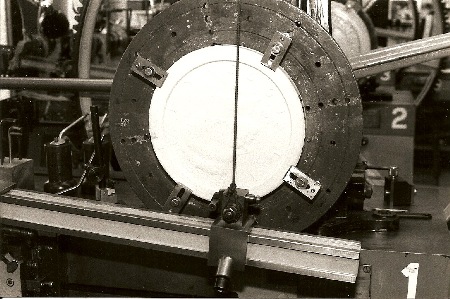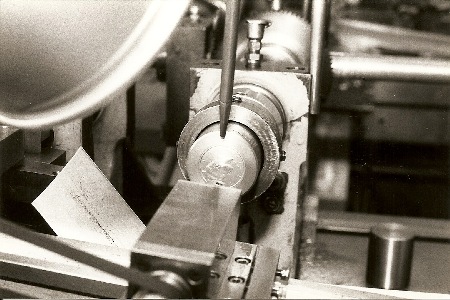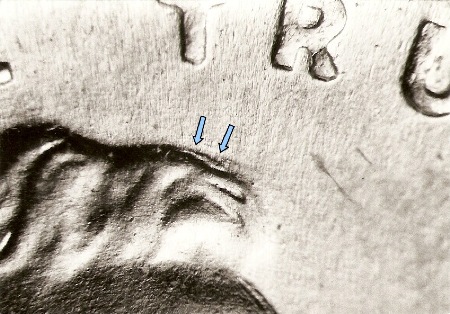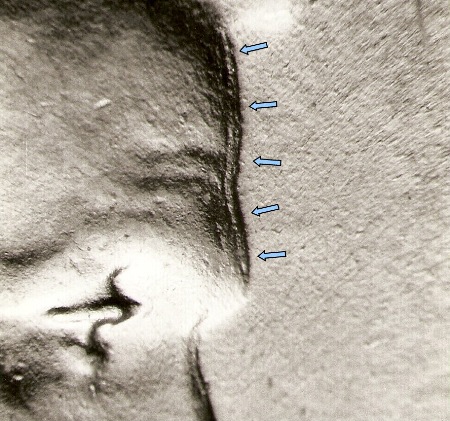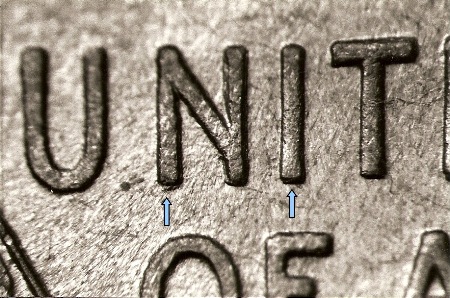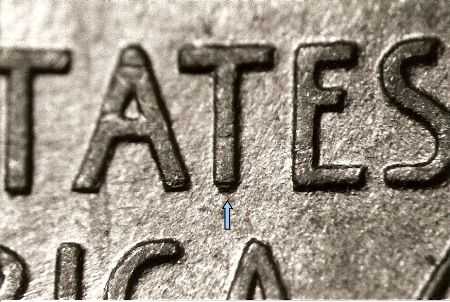


 |
 |
 |
 |
 |
 |
 |
 |
 |
 |
 |
 |
 |
 |
 |
 |
 |
 |
 |
 |
 |
 |
 |
 |
The Mint started using reduction lathes in 1836 to transfer designs from a master model (galvano) to the face of a master hub. These reduction lathes were pantographs with two arms. One arm traced out the design on the galvano while the other reduced it proportionately and cut it into the face of the master hub. It was a very slow and tedious process and took anywhere from a day and a half to two days to complete a master hub.
This is a photo of some of the Janvier Reduction Lathes in use at the Philadelphia Mint in 1998. The white discs at the center of each lathe are galvanos.
In this close up of a galvano at the center of a Janvier Reduction Lathe, the device at the bottom is tracing out the design on a galvano for the Kennedy half dollar.
Here we see the same Janvier Reduction Lathe, but this is the master hub for the Kennedy half dollar galvano seen in the previous photo. Again the device at the bottom is carving out the design. As the design on the galvano was being traced and cut into the face of the master hub, one of the arms cutting the design into the face of the master hub would sometimes slip slightly and change orientation. Since the design was retraced several times on the galvano, the area in which the arm slipped on the master hub would have the same design carved into it in two slightly different locations producing a doubled image in the area. Keep in mind that this doubling is on the master hub. The master hub will then produce the master die for that year which in turn will produce all of the working hubs for that year. The working hubs will in turn produce all of the working dies for that year. This means that all of the working dies for that denomination will have the exact same doubling and consequently so will all of the coins of that denomination for that year. But it gets worse. Remember that until the final two digits of the date were added to the master design in the mid-1980s, the intent was to use the master hub over a period of several years. This means that not only will the doubled image appear on all coins of that denomination produced that year, but it will be found on all coins of that denomination for all of the years in which that doubled master hub is used to produce master dies. This identical doubling which will appear on coins over a span of several years is referred to as “series doubling” by some in the hobby. Since this doubling appears on all coins of that denomination in a given year, there is nothing special about it. To say that it is common is a gross understatement. As a result, coins bearing doubling that traces back to the master hub will have no extra value for the doubling. While the doubling does ultimately appear on the working dies, in the Wexler Die Variety Files we do not classify these as “doubled dies.” We define doubled dies to be doubling on a hub or die that is produced by misalignments of the hub and die in the hubbing press. Since this doubling was produced in the process of engraving the design onto the master hub, we classify this as a form of “engraving doubling.” One such doubled master hub was used to produce Lincoln cent master dies for a period of several years ranging from the early 1930’s into the 1950’s. The doubling can be clearly seen on Lincoln’s forehead and also as an extra fold of hair above the front curl of hair just above the front of the forehead.
This is the extra lock of hair at the top of Lincoln's head just above the front of the forehead as seen on Lincoln cents from the early 1930's into the 1950's.
This photo shows the reduction lathe doubling seen on Lincoln's forehead during that same period of time. A doubled master hub was the culprit. We frequently get reports from collectors new to the variety hobby that they have found Lincoln cents with this doubling. They want to know what their discoveries are worth. It is always difficult trying to tell them that their doubled coins have no extra value. Another doubled master hub can be found for the reverse of the 1909 Lincoln cents. It shows doubling on the lower letters of UNITED STATES OF AMERICA and CENT. This doubled master hub was used to produce doubled master dies for a period of several years after 1909.
This doubling seen at the bottoms of the N and I of UNITED is from a doubled master hub. It can be found for several years after 1909.
The doubling seen here at the bottom of the 2nd T in STATES is more of the reduction lathe doubling that produced a doubled working hub in 1909. If you have a Washington quarter collection, look closely at the lower left leaves, the lower left branch, and some of the letters of QUARTER on the reverse of your quarters dated from 1967 through 1974. The reverse of these quarters shows the doubling in the lower left part of the reverse throughout all of these years. The culprit was once again reduction lathe doubling. Here again, as with the Lincoln cent examples already mentioned, there is no extra value for this doubling even though on early die state specimens throughout these years the doubling shows quite well. Numerous other examples of reduction lathe doubling exist for the modern coinage series, but these should serve to let you know what they look like and how they are produced. It will be interesting to see if any reducing doubling results from the new CNC Milling Machines that the Mint now uses instead of the Janvier Reduction Lathes which are now a thing of the past. | ||


